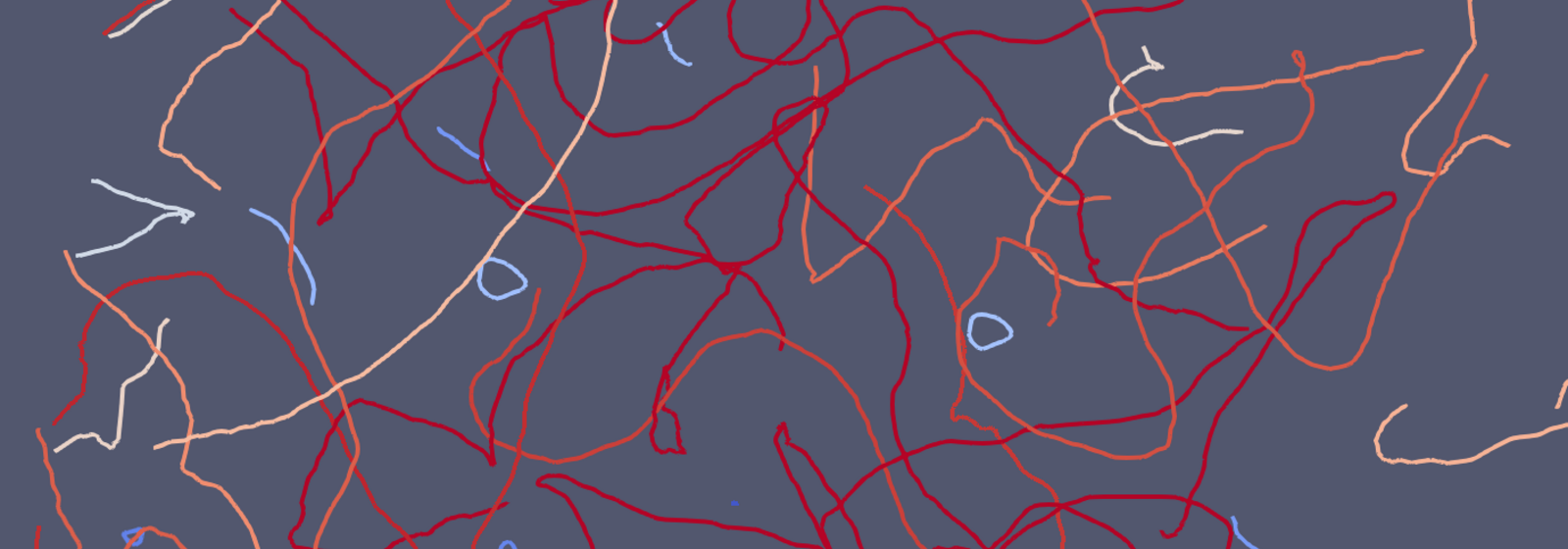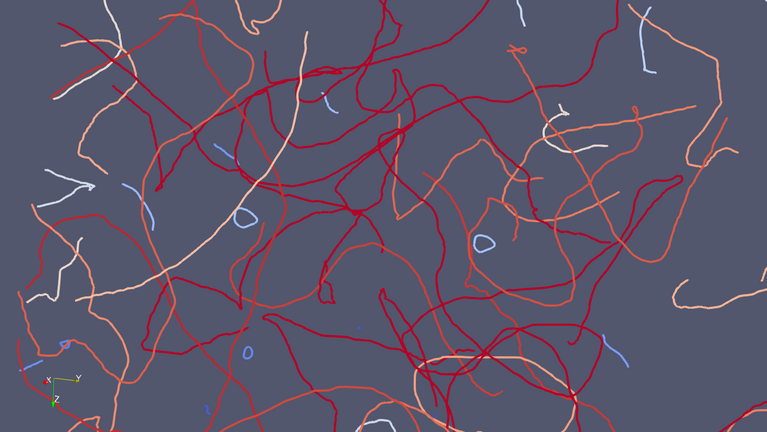February 09, 2021 - by Simone Ulmer
Topological defects form during phase transitions. On a small scale, for example, these happen when the crystal lattice of a crystal does not form perfectly. On a large scale, they are suspected to have occurred in the early formation of the universe some 13.8 billion years ago. The leading theory for the formation of topological defects in the universe — including those known as cosmic strings — states that they were created within a fraction of a second after the Big Bang, when the so-called inflation ended with a phase transition.
The universe started in a hot, dense, and highly symmetric state, but after the Big Bang, it evolved through exponential expansion and subsequent cooling. A consequence of the cooling was that the initial symmetric properties got lost in specific symmetry-breaking phase transitions. Throughout this process, the universe was already so huge that regions far apart from each other were effectively disconnected and could not even exchange information at the speed of light. In simple terms, the symmetry breaking could therefore not be universally identical, resulting in regions with different field states developing across the cosmos. Where these different regions met, topological defects like cosmic strings could develop, according to the theory. The so-called Kibble mechanism describes how this is supposed to happen, and cosmic strings can thereby form in many extensions of the Standard Model of particle physics.
Fossil relics of the early universe
In their study recently published in the journal Astronomy and Computing, Ph.D student José Correia and Carlos Martins, professor at the Center for Astrophysics of the University of Porto describe cosmic strings as fossil relics of the early universe because they and their properties are closely related to symmetry breaking. The search for defects in the early or modern universe is therefore similar to the search for evidence of specific patterns of symmetry breaking. Proof of their existence would extend the current Standard Model of particle physics and could also help answer some open questions.
So far, however, the existence of cosmic strings has not been proven. "These defects encode information on fundamental physics regimes that would otherwise be entirely inaccessible to us," says Martins. "Searching for their observational imprints, for example in gravitational waves and the cosmic microwave background, is a key goal of current and forthcoming observational facilities."
To interpret the observed data, analytical models are used. Martins himself developed the so-called Velocity-Dependent One-Scale Model to help understand topological defects and their formation. The models are in turn calibrated with high-resolution simulations that recreate the evolution of cosmic strings and enable the study of their dynamics, development, and effects.
Unfortunately, even the simplest of cosmic strings, known as Abelian Higgs, quickly exhaust the capacity and performance of the computers available today due to the many physical effects and the wide range of scales that must be considered in the simulation. This means that current observational searches are bottlenecked by the lack of numerical simulations with sufficient spatial resolution and dynamic range to calibrate existing analytic models. "So far, simulations are performed on standard CPUs, but there are only about a dozen reasonably accurate simulations. And only three or four research groups have the relevant know-how," says Martins. As a result, the current analyses are statistically limited.
In-situ visualisations
Martins and his PhD student Correia appear to have solved this bottleneck in the simulation of Abelian-Higgs cosmic strings by improving and implementing a multiple GPU extension of the evolution code for local Abelian–Higgs strings networks. The researchers also use in-situ visualisation, which can, on the fly, look at the small-scale structure of each string as though it were under the microscope.
"In order to study this, we need to output the positions of string cores in the lattice, but this generates an unreasonable amount of data," Correia explains. The researchers therefore enlisted the support of CSCS software engineer and visualisation specialist Jean Favre to combine the simulation code with the visualisation code (ParaView Catalyst) so that both work with the same data stored in computer memory. "The in-situ visualisations were used to filter and output only the grid cells penetrated by strings and, in each cell, which cell faces are penetrated," says Correia. "This speeds up the simulations considerably and reduces the amount of data generated by the calculation of 20483 grid points in the three-dimensional lattice by up to four orders of magnitude for a radiation era test case."
The newly implemented code runs on 4,096 graphics processors of the CSCS supercomputer "Piz Daint". "The code scales much better, so it reaches the target in calculations about 30 times faster than simulations on conventional CPU processors," says Correia. The researchers successfully validated the code against previous results in the literature.
Observational research will be optimised
"These accelerations, together with state-of-the-art GPU resources, for the first time allow hundreds or thousands of high-resolution simulations with sufficient dynamics to evolve cosmic strings in a useful time-frame," says Martins. This will soon allow a robust, full statistical calibration of the analytical models. "Ultimately, this will lead to significantly optimised observational searches with next-generation astrophysical facilities and more stringent constraints on the underlying physics," Martins adds. Examples of observation facilities that could benefit from this advancement include facilities on the ground like the Laser Interferometer Gravitational-Wave Observatory (LIGO), which detected gravitational waves for the first time, and the Square Kilometre Array (SKA), or the Laser Interferometer Space Antenna (LISA), a space-based gravitational wave detector. Their measuring devices can detect gravitational waves emitted by cosmic strings under certain conditions: The theory is that if a cosmic string — a one-dimensional line-like object — crosses itself, a loop is formed that is cut off at the pinch-off point. The loop then dispels energy and consequently emits gravitational waves.
"In the medium term, our methods will also enable the first numerical studies of more complex physical objects, such as superconducting strings and cosmic superstrings, which, according to some extensions of the Standard Model, must have formed in the early universe," Martins says. The scientists are convinced that their work opens a new numerical and astrophysical way of probing fundamental physics by complementing and extending what is done in particle accelerators.
Reference:
Correia J.R.C.C.C. and Martins C.J.A.P.: Abelian-Higgs cosmic string evolution with multiple GPUs, Astronomy and Computing (2020), https://doi.org/10.1016/j.ascom.2020.100438
Information:
This project was supported by PRACE, the Partnership for Advanced Computing in Europe. 19th Project Access Call; Project Title: Abelian-Higgs cosmic strings: network evolution. Resources awarded: 68 million core hours on Piz Daint hosted by CSCS.
Related articles:
This article may be used on other media and online portals provided the copyright conditions are observed.

